Abstract
We describe here a family of biomimetic iron carriers that display high binding efficiency for ferric ions and favorable permeation properties across erythrocytic membranes. These carriers inhibit in vitro growth of Plasmodium falciparum by scavenging intracellular iron. The chemical features were realized by reproducing the iron-binding cavities of natural iron carriers (siderophores) and by systematic substitutions of their hydrophilic envelopes for more hydrophobic ones. In contrast to natural carriers, which participate in receptor-mediated iron uptake in cells and act as growth promoters, our synthetic carriers were designed to penetrate cellular membranes by diffusion, scavenge intracellular iron, and thereby act as growth inhibitors. Based on these properties we designate the compounds reversed siderophores and refer to the specific analogs of the natural ferrichrome as synthetic ferrichromes. The antimalarial activity of the synthetic ferrichromes correlated with their lipophilicity, and this antimalarial activity was averted when the chelators were applied as iron (III) complexes. The sites of synthetic ferrichrome action reside in the intraerythrocytic parasite and not in serum or on normal erythrocyte components. The agents were effective against all stages of parasite growth and against a variety of multidrug-resistant strains of P. falciparum. The most potent agent of this synthetic ferrichrome series, SF1-ileu, was not toxic to mammalian cells in culture and was 15-fold more potent and 20-fold faster acting than desferrioxamine. Taken in toto, these agents constitute a series of promising candidates for future use in malaria chemotherapy.
Full text
PDF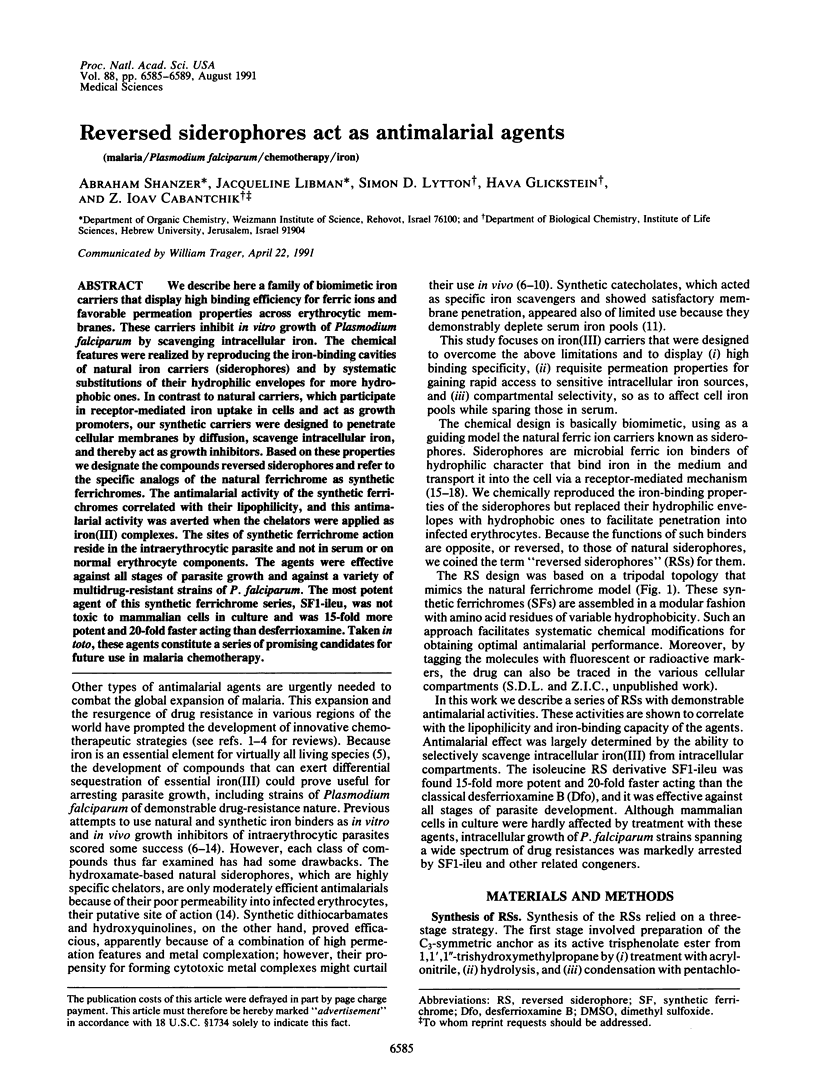
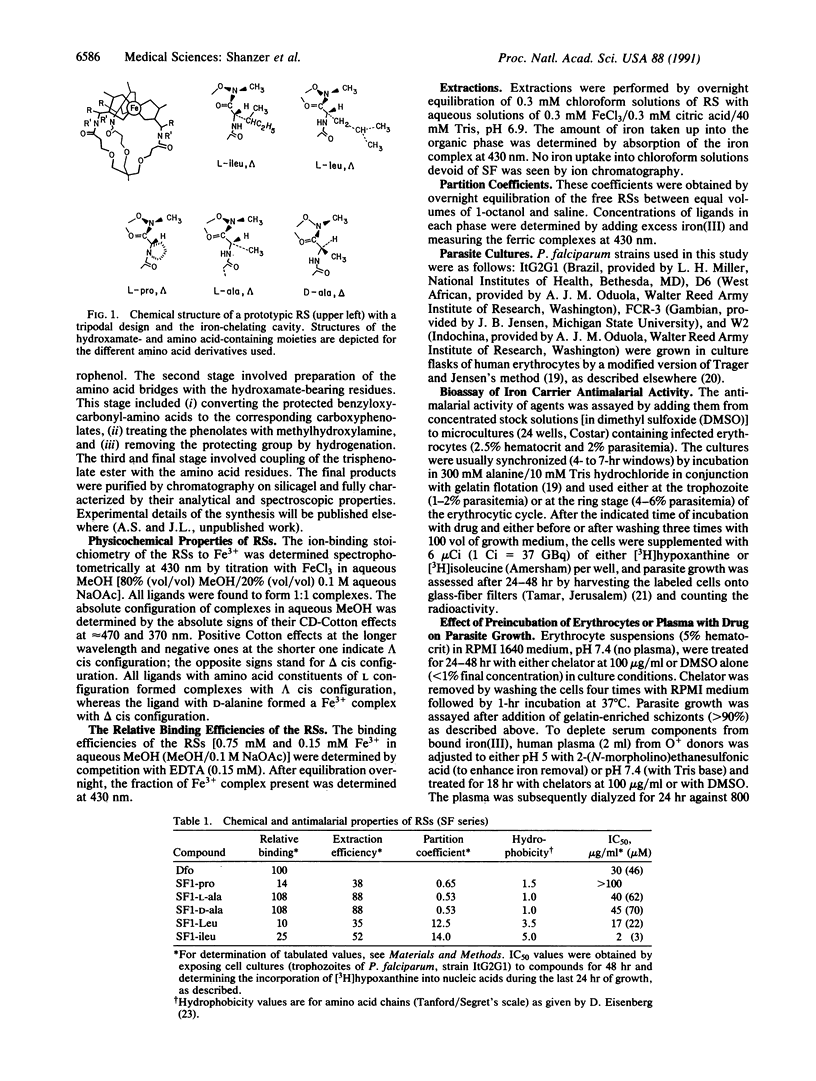
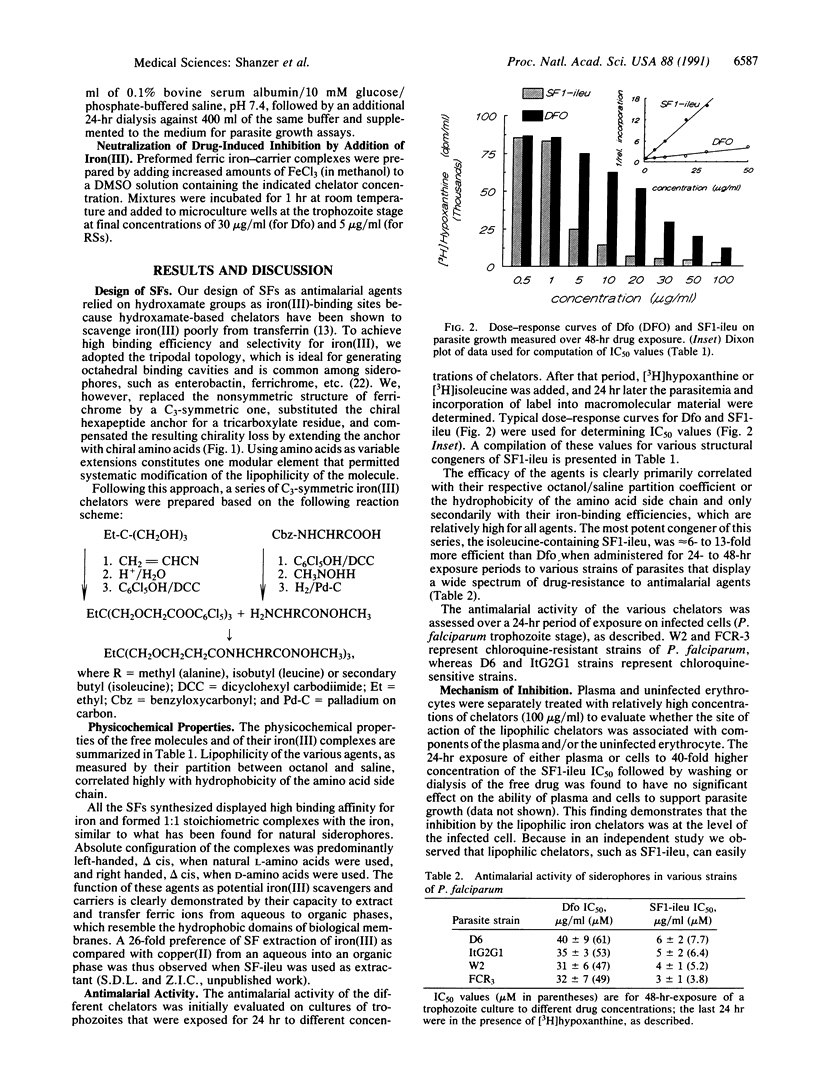
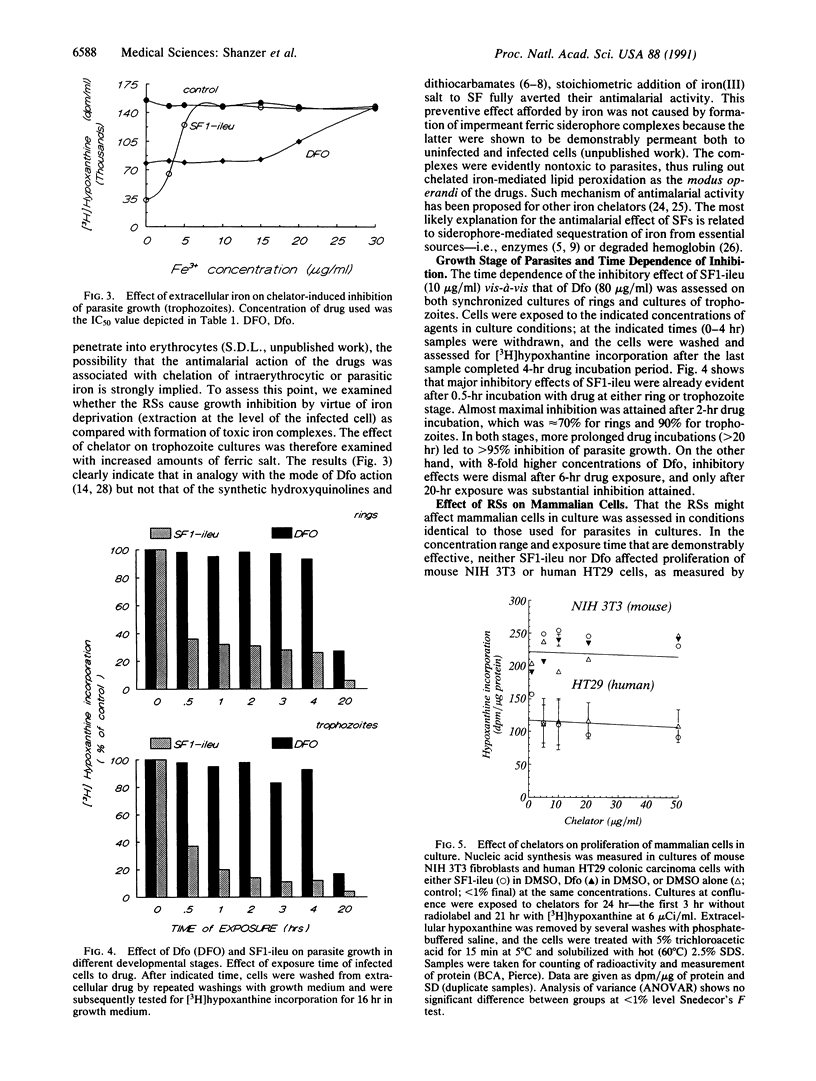
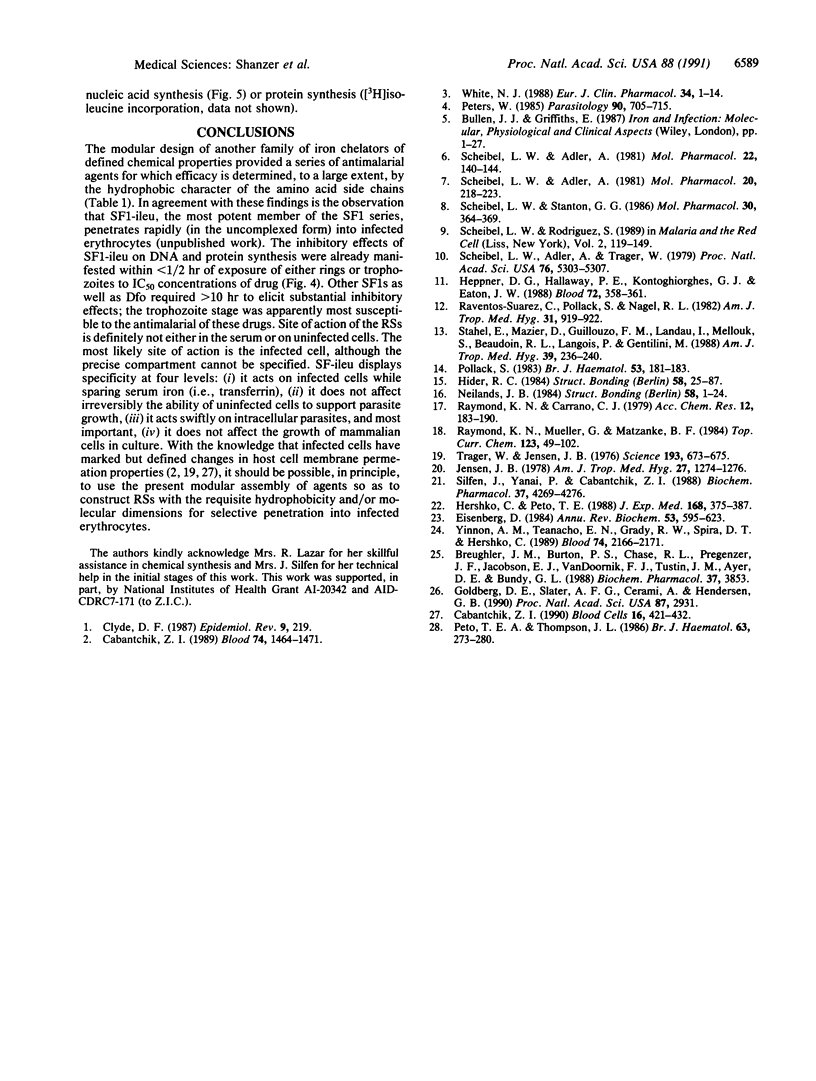
Selected References
These references are in PubMed. This may not be the complete list of references from this article.
- Braughler J. M., Burton P. S., Chase R. L., Pregenzer J. F., Jacobsen E. J., VanDoornik F. J., Tustin J. M., Ayer D. E., Bundy G. L. Novel membrane localized iron chelators as inhibitors of iron-dependent lipid peroxidation. Biochem Pharmacol. 1988 Oct 15;37(20):3853–3860. doi: 10.1016/0006-2952(88)90066-4. [DOI] [PubMed] [Google Scholar]
- Cabantchik Z. I. Properties of permeation pathways induced in the human red cell membrane by malaria parasites. Blood Cells. 1990;16(2-3):421–432. [PubMed] [Google Scholar]
- Cabantchik Z. L. Altered membrane transport of malaria-infected erythrocytes: a possible pharmacologic target. Blood. 1989 Oct;74(5):1464–1471. [PubMed] [Google Scholar]
- Clyde D. F. Recent trends in the epidemiology and control of malaria. Epidemiol Rev. 1987;9:219–243. doi: 10.1093/oxfordjournals.epirev.a036303. [DOI] [PubMed] [Google Scholar]
- Eisenberg D. Three-dimensional structure of membrane and surface proteins. Annu Rev Biochem. 1984;53:595–623. doi: 10.1146/annurev.bi.53.070184.003115. [DOI] [PubMed] [Google Scholar]
- Goldberg D. E., Slater A. F., Cerami A., Henderson G. B. Hemoglobin degradation in the malaria parasite Plasmodium falciparum: an ordered process in a unique organelle. Proc Natl Acad Sci U S A. 1990 Apr;87(8):2931–2935. doi: 10.1073/pnas.87.8.2931. [DOI] [PMC free article] [PubMed] [Google Scholar]
- Heppner D. G., Hallaway P. E., Kontoghiorghes G. J., Eaton J. W. Antimalarial properties of orally active iron chelators. Blood. 1988 Jul;72(1):358–361. [PubMed] [Google Scholar]
- Hershko C., Peto T. E. Deferoxamine inhibition of malaria is independent of host iron status. J Exp Med. 1988 Jul 1;168(1):375–387. doi: 10.1084/jem.168.1.375. [DOI] [PMC free article] [PubMed] [Google Scholar]
- Jensen J. B. Concentration from continuous culture of erythrocytes infected with trophozoites and schizonts of Plasmodium falciparum. Am J Trop Med Hyg. 1978 Nov;27(6):1274–1276. doi: 10.4269/ajtmh.1978.27.1274. [DOI] [PubMed] [Google Scholar]
- Peters W. The problem of drug resistance in malaria. Parasitology. 1985 Apr;90(Pt 4):705–715. doi: 10.1017/s003118200005232x. [DOI] [PubMed] [Google Scholar]
- Peto T. E., Thompson J. L. A reappraisal of the effects of iron and desferrioxamine on the growth of Plasmodium falciparum 'in vitro': the unimportance of serum iron. Br J Haematol. 1986 Jun;63(2):273–280. doi: 10.1111/j.1365-2141.1986.tb05550.x. [DOI] [PubMed] [Google Scholar]
- Pollack S. Malaria and iron. Br J Haematol. 1983 Feb;53(2):181–183. doi: 10.1111/j.1365-2141.1983.tb02009.x. [DOI] [PubMed] [Google Scholar]
- Raventos-Suarez C., Pollack S., Nagel R. L. Plasmodium falciparum: inhibition of in vitro growth by desferrioxamine. Am J Trop Med Hyg. 1982 Sep;31(5):919–922. doi: 10.4269/ajtmh.1982.31.919. [DOI] [PubMed] [Google Scholar]
- Scheibel L. W., Adler A. Antimalarial activity of selected aromatic chelators. II. Substituted quinolines and quinoline-N-oxides. Mol Pharmacol. 1981 Jul;20(1):218–223. [PubMed] [Google Scholar]
- Scheibel L. W., Adler A. Antimalarial activity of selected aromatic chelators. III. 8-Hydroxyquinolines (oxines) substituted in positions 5 and 7, and oxines annelated in position 5,6 by an aromatic ring. Mol Pharmacol. 1982 Jul;22(1):140–144. [PubMed] [Google Scholar]
- Scheibel L. W., Adler A., Trager W. Tetraethylthiuram disulfide (Antabuse) inhibits the human malaria parasite Plasmodium falciparum. Proc Natl Acad Sci U S A. 1979 Oct;76(10):5303–5307. doi: 10.1073/pnas.76.10.5303. [DOI] [PMC free article] [PubMed] [Google Scholar]
- Scheibel L. W., Rodriguez S. Antimalarial activity of selected aromatic chelators V. Localization of 59Fe in Plasmodium falciparum in the presence of oxines. Prog Clin Biol Res. 1989;313:119–149. [PubMed] [Google Scholar]
- Scheibel L. W., Stanton G. G. Antimalarial activity of selected aromatic chelators. IV. Cation uptake by Plasmodium falciparum in the presence of oxines and siderochromes. Mol Pharmacol. 1986 Oct;30(4):364–369. [PubMed] [Google Scholar]
- Silfen J., Yanai P., Cabantchik Z. I. Bioflavonoid effects on in vitro cultures of Plasmodium falciparum. Inhibition of permeation pathways induced in the host cell membrane by the intraerythrocytic parasite. Biochem Pharmacol. 1988 Nov 15;37(22):4269–4276. doi: 10.1016/0006-2952(88)90606-5. [DOI] [PubMed] [Google Scholar]
- Stahel E., Mazier D., Guillouzo A., Miltgen F., Landau I., Mellouk S., Beaudoin R. L., Langlois P., Gentilini M. Iron chelators: in vitro inhibitory effect on the liver stage of rodent and human malaria. Am J Trop Med Hyg. 1988 Sep;39(3):236–240. doi: 10.4269/ajtmh.1988.39.236. [DOI] [PubMed] [Google Scholar]
- Trager W., Jensen J. B. Human malaria parasites in continuous culture. Science. 1976 Aug 20;193(4254):673–675. doi: 10.1126/science.781840. [DOI] [PubMed] [Google Scholar]
- White N. J. Drug treatment and prevention of malaria. Eur J Clin Pharmacol. 1988;34(1):1–14. doi: 10.1007/BF01061409. [DOI] [PubMed] [Google Scholar]
- Yinnon A. M., Theanacho E. N., Grady R. W., Spira D. T., Hershko C. Antimalarial effect of HBED and other phenolic and catecholic iron chelators. Blood. 1989 Nov 1;74(6):2166–2171. [PubMed] [Google Scholar]


